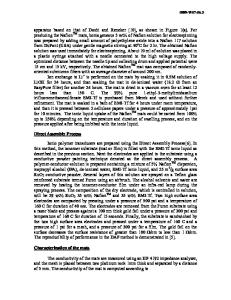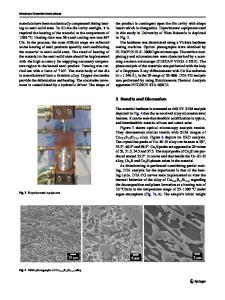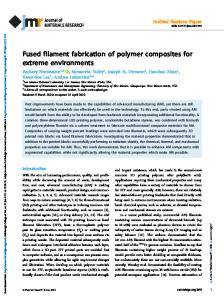A Cost-Effective Fabrication Method for Ionic Polymer-Metal Composites
- PDF / 107,560 Bytes
- 6 Pages / 612 x 792 pts (letter) Page_size
- 28 Downloads / 394 Views
0889-W04-03.1
A Cost-Effective Fabrication Method for Ionic Polymer-Metal Composites M. Siripong, S. Fredholm, Q.A. Nguyen, B. Shih, J. Itescu, and J. Stolk Franklin W. Olin College of Engineering Olin Way Needham, MA 02492 ABSTRACT To date, many processes have been used for the preparation of ionic polymer-metal composite (IPMC) artificial muscle membranes from conductive metals and perfluorosulfonic polymers such as Nafion. The most widely used of these methods is the platinum plating process, which involves chemical reduction of ionic salt solutions. Although these chemical electroding techniques produce IPMCs with outstanding surface electrodes and excellent performance characteristics, they are relatively costly and time-consuming. In this paper, we describe a novel fabrication process for fast preparation of low-cost Ni-Au-Nafion IPMCs. The process involves the formation of an adherent surface layer on prepared Nafion through DC sputter deposition of a fine-grained gold film, followed by electroplating of a thin and ductile nickel layer in a solution of aqueous nickel salts and boric acid. Preliminary results indicate that the Nafion-117-based IPMCs produced using this technique exhibit good surface conductivity and promising actuation performance, with 20 mg, 11.5 mm x 4.7 mm cantilever bending samples showing high displacements and tip forces up to 4 grams at 4 V. Our current research efforts are focused on achieving repeatable synthesis techniques and evaluating the properties and performance characteristics of the Au-Ni-Nafion IPMCs, especially in comparison to the popular platinum IPMCs. INTRODUCTION The search for smart artificial muscle materials has led to investigations of numerous systems, including piezoelectric ceramics and polymers, shape memory metals and polymers, electromagnetic voice coils, magnetostrictive alloys, electrostatic integrated force arrays, and electrically active polymeric gels. Of the material systems with demonstrated muscle-like actuation, electroactive polymers (EAPs) exhibit properties most closely matching those of natural muscle, and thus show promise as future artificial muscle materials [1-6]. One group of EAPs attracting great interest are ion exchange polymers, many of which actuate at low voltages and show potential for use in soft biological and robotic actuators. Ionic polymer-metal composites (IPMCs), which consist of thin ion exchange membranes, such as Nafion, bonded to conductive surface electrodes, are soft actuators that offer low density, quick response, and large actuation strains under low electric fields. The state-of-theart method for manufacturing IPMCs is a platinum chemical plating process that involves several steps: (i) ion exchange via submersion in an aqueous solution of a metal salt such as tetraammineplatinum(II) chloride ([Pt(NH3)4]Cl2⋅xH2O), (ii) chemical reduction of the surface metallic ions with sodium borohydride (NaBH4), lithium borohydride (LiBH4), or hydrazine hydrate (H4N2⋅xH2O), and (iii) surface electroding to produce a highly conduc
Data Loading...











